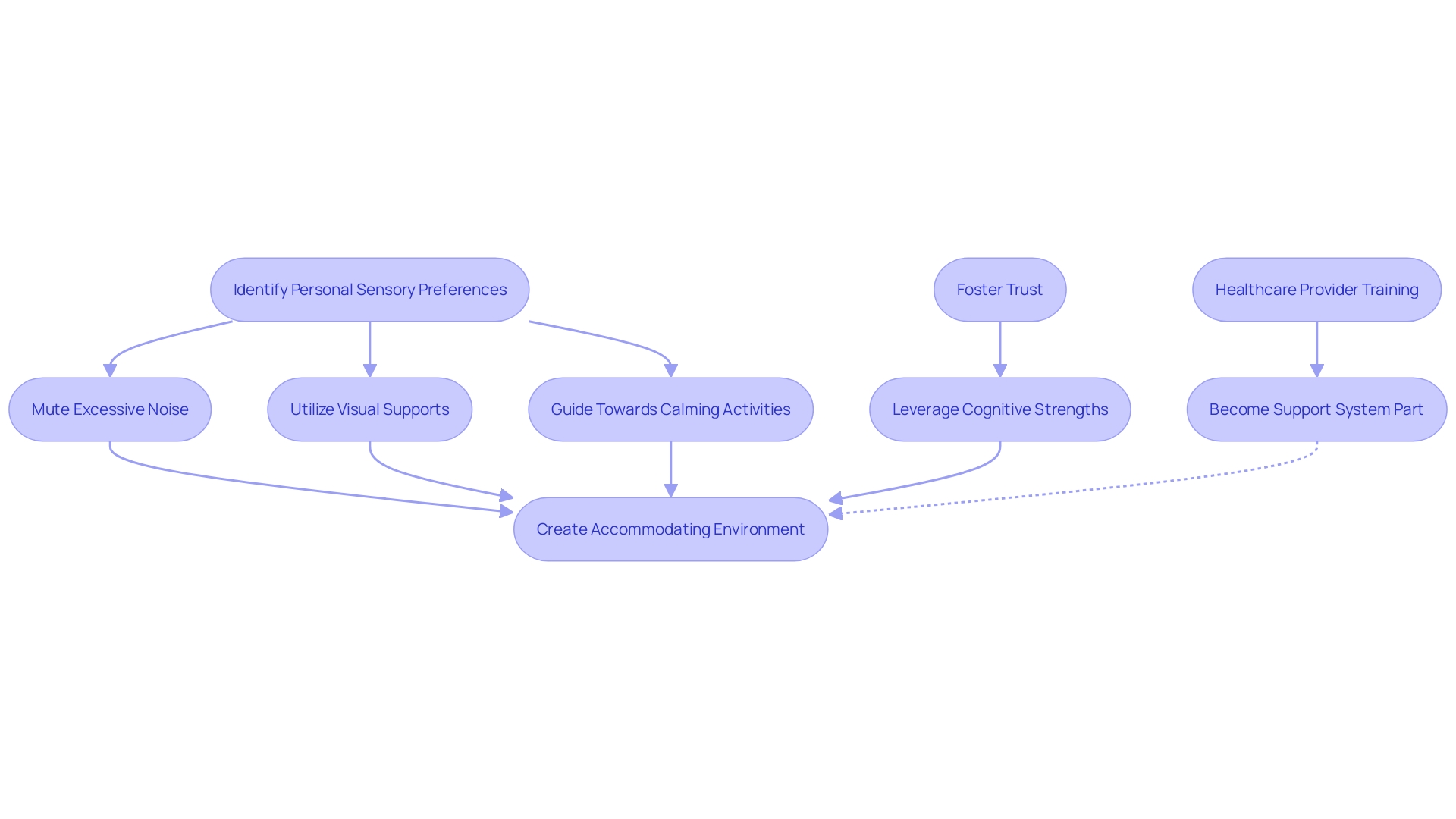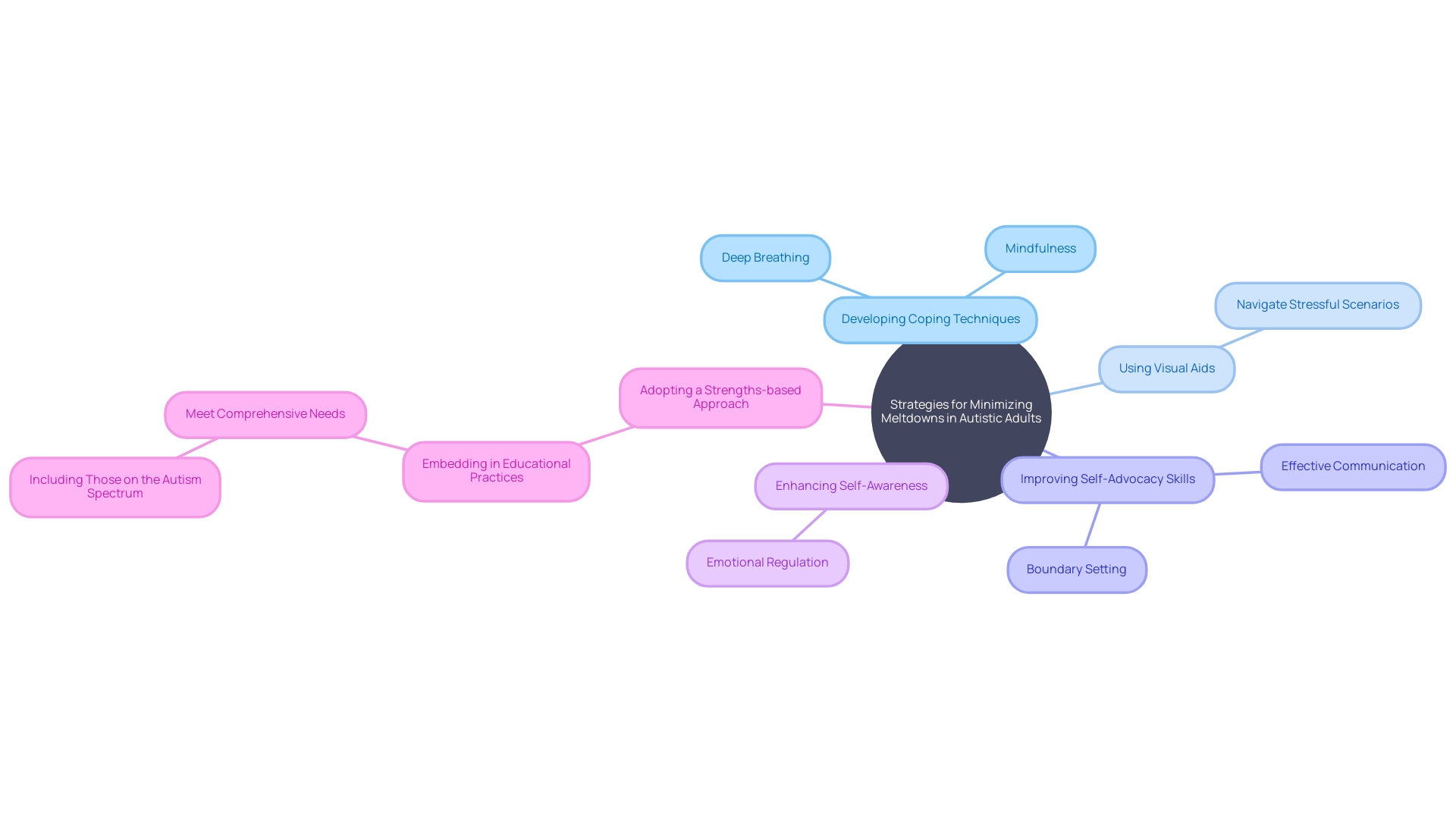Introduction
Navigating the complexities of autism spectrum disorder (ASD) can present unique challenges for families, particularly when it comes to understanding and managing autistic meltdowns. While often associated with children, adults with autism also experience overwhelming heightened responses. Recognizing the early signs of a meltdown and providing timely support can make a significant difference in de-escalation.
This article explores the importance of recognizing and understanding the signs of an impending meltdown, strategies for preventing meltdowns, providing sensory support and management, and teaching coping strategies. By adopting an informed and proactive approach, caregivers and support systems can ensure the well-being and stability of autistic adults.
Understanding Autistic Meltdown in Adults
Families navigating the complexities of autism spectrum disorder (ASD) understand that individuals on the spectrum can experience overwhelming heightened responses, often referred to as autistic meltdowns. Such reactions are not exclusive to children; adults with autism can also find themselves facing these intense moments. Indeed, when sensory or social inputs become too much to handle, it can result in a cascade of emotional and physical responses.
Recognizing the early signs is crucial, as support from family members, caregivers, and professionals can be the difference between escalation and de-escalation of these episodes.
We know that adults with autism are constantly adapting to a world primarily designed for neurotypical individuals, which can be a source of immense stress. Harvard Medical School's Adult Autism Health Resources initiative emphasizes the need for quality healthcare for this demographic, noting that beyond high school, autistic adults often lose access to many essential services. This places an even greater responsibility on their support systems to ensure not only their medical well-being but also their mental health.
Maintaining physical self-care is fundamental, as neglect can exacerbate the challenges faced by these individuals.
The societal lack of understanding of autism's nuances can contribute to the stresses that trigger meltdowns. Traffic control devices, for example, can be a potential stressor—an interesting research comparison on road safety by Srinivasan et al. found that fluorescent-colored warning signs could significantly reduce accidents, which suggests that tailored environments are beneficial in mitigating autism-related challenges.
In mitigating these challenges, caregivers bear a great responsibility, and as one expert puts it, "Caregivers are responsible for understanding their child’s medications, weighing the risks against the benefits and observing changes in their behavior." As such, informed vigilance is key, with the recognition that repeated research fosters a current and educated approach to autism care.
Understanding the full scope of autism's impact on the individual and their loved ones requires a multifaceted, informed approach that addresses not just immediate needs but also the ongoing support systems necessary to foster a stable, caring environment that can anticipate and mitigate the stress that can lead to an adult's autistic meltdown.
Signs of an Impending Meltdown
Recognizing the signs that preempt a meltdown in individuals with autism is a matter of critical importance for caregivers and family members. Early intervention can mitigate the intensity or even avert the meltdown altogether. Key indicators to watch for include a rise in anxiety or agitation, an overwhelming response to sensory inputs, struggles with verbal expression or social exchanges, and a noticeable increase in frustration.
Sensitivity to these early warnings enables those close to the individual to provide timely support and maintain calm.
The American Psychiatric Association delineates these markers in the DSM-5, underscoring their significance in the diagnostic process. Furthermore, research by Srinivasan et al. on the impact of warning signs' visibility suggests that clarity in communication—similar to that which helps prevent traffic accidents—could also be beneficial in preempting autistic meltdowns by helping caregivers and autistic individuals understand and respond to signs of distress more effectively.
Tragically, children on the autism spectrum are considerably more vulnerable to injury, with statistics indicating a 40-fold increase in the likelihood of injury-related mortality compared to their non-autistic peers. This data highlights the necessity for heightened vigilance and protective measures for autistic individuals, particularly in potentially hazardous environments like traffic settings.
In light of these observations and research findings, family members and caregivers are encouraged to develop an understanding akin to the vigilance used in traffic safety: anticipating challenges before they arise, and using clear, prompt interventions to support those with autism spectrum disorder during vulnerable moments.
Strategies for Preventing Meltdowns
Understanding the complex nature of autism involves considering each individual as a dynamic system, where emotions and behaviors emerge from ongoing interactions with their environment. In supporting adults with autism, strategies to prevent overwhelming situations are vital. These approaches encompass providing a sensory-friendly atmosphere to mitigate overstimulation, a structured routine to foster predictability, and enhancing communication to support self-expression and understanding.
Recognizing the importance of autonomy, avenues for self-regulation and self-care are also crucial, particularly as this proactive support is capable of reducing the severity and occurrence of challenging episodes.
Focusing on the fluidity of complex systems, this continuous, detailed observation of interactions can lead to an integrated comprehension of autistic individuals over time. Groundbreaking studies have leveraged the extensive datasets from organizations like The Center for Discovery, harnessing AI and machine learning to preemptively identify when a significant behavior might arise, thereby allowing for strategic intervention to lessen its impact on the individual and their surroundings. In the larger context of mental health and equity, taking measures to decrease stressors and support caregivers reinforces the commitment to creating an inclusive environment where individuals with disabilities, including autism, can thrive.
Providing Sensory Support and Management
Creating an accommodating environment for autistic adults necessitates a compassionate approach that recognizes their unique sensory thresholds. Sensory sensitivities often shape the experiences of individuals with autism, and these sensory challenges can escalate rapidly if not properly managed. By modulating environmental factors—like muting excessive noise, utilizing visual supports such as schedules, social narratives, and guiding them towards calming sensory-based activities—a serene atmosphere can be crafted to facilitate self-regulation and decrease the likelihood of overwhelming moments, commonly termed as meltdowns.
Understanding these personal sensory preferences is not just about comfort—it's a critical practice for fostering trust and enhancing the overall well-being of autistic adults. It's particularly relevant in healthcare settings, where even the feel of a chair or the sound of medical equipment can prove distressing. An innovative example of this in practice includes the development of an AR application designed to translate tactile sensations into visual and auditory cues for those with heightened tactile sensitivities.
By adopting strategies that account for the full spectrum of sensory experiences—the tactile, proprioceptive, and vestibular systems—we can offer support that not only accommodates but also leverages the cognitive strengths of autistic individuals. Many possess remarkable abilities to process visual and auditory information, and by rendering environments that play to the strengths, we create a space where these adults can thrive.
It's imperative for healthcare providers to embrace a willingness to learn about and cater to the distinctive needs of autistic patients. As research illustrates, for autistic persons, therapeutic requirements for conditions like anxiety and depression are generally in line with the rest of the population. Yet, too often they face barriers in accessing support, leading to unmet healthcare needs and a heightened risk of co-occurring conditions.
Training healthcare practitioners in the specifics of autism can ensure that they are not just serviceable, but become integral parts of the support system for autistic adults.

Teaching Coping Strategies
For autistic adults, developing coping strategies is vital in minimizing and managing the occurrence of meltdowns. These techniques, rooted in relaxation methods like deep breathing or mindfulness, benefit from visual aids that illustrate how to navigate stressful scenarios. Crucially, learning how to effectively communicate needs and set clear boundaries through self-advocacy skills is also part of this education.
Enhancing self-awareness and honing emotional regulation are important facets of this process, equipping individuals in better handling overwhelming situations and contributing to a decrease in meltdown incidences.
One must consider how each individual's specific needs and abilities can guide the way coping strategies are taught and applied, ensuring that the approaches adopted are as personalized as they are effective. Such individualized attention to learners' unique talents, abilities, and interests has been anchored in the strengths-based approach, which has been proven to optimize learning and foster professional growth. Moreover, embedding such tailored interventions in routine educational practices can ensure that all students, including those on the autism spectrum, have their needs met comprehensively.

Conclusion
In conclusion, caregivers and support systems play a crucial role in understanding and managing meltdowns in autistic adults. Recognizing early signs, such as anxiety and sensory overload, is vital for timely support and de-escalation. Preventative strategies like sensory-friendly environments and structured routines can help minimize meltdowns.
Providing sensory support and management through environmental adjustments and understanding individual sensory preferences is essential. Healthcare providers should learn and cater to the unique needs of autistic patients. Teaching coping strategies, including relaxation techniques and effective communication, can empower individuals to better handle overwhelming situations.
Personalized approaches that consider individual strengths and abilities contribute to overall well-being. By adopting an informed and proactive approach, caregivers can ensure the well-being and stability of autistic adults. Through continuous education, understanding, and support, we can create an environment where autistic adults can thrive.




